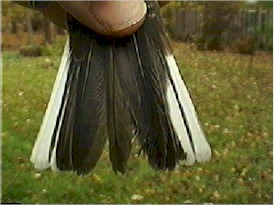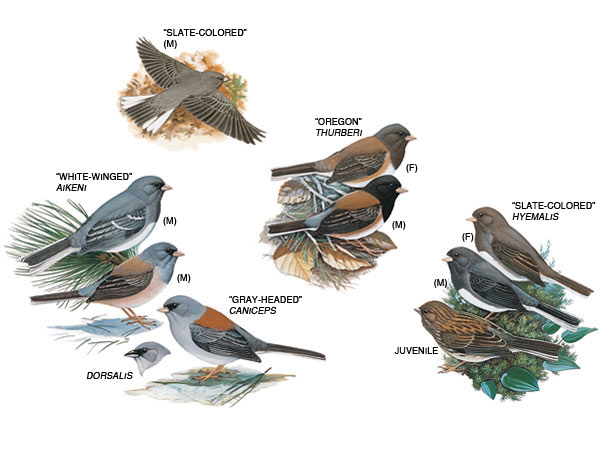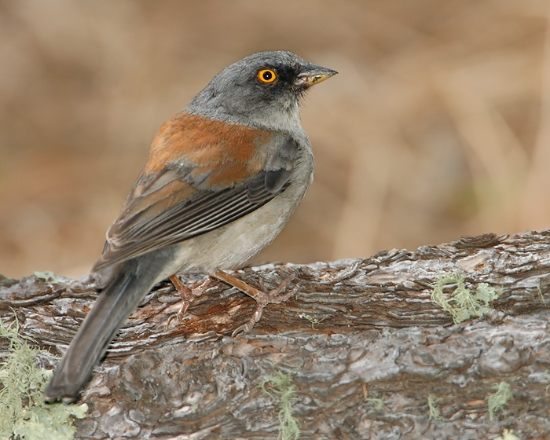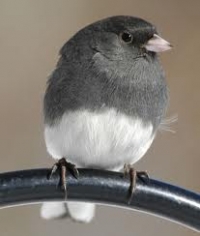 SPOILER ALERT!! One of the best parts of the film explores a rogue population of juncos living on the University of California- San Diego campus. The population is isolated hundreds of miles from the next closest population and no longer finds the need to migrate. The UC-SD urban population exhibits different personality traits and behaviors from that of the less urban populations. Super cool. But the even cooler part is that this non-migratory urban population was discovered by an 8 year-old girl! Don't you love when that type of thing happens?!
SPOILER ALERT!! One of the best parts of the film explores a rogue population of juncos living on the University of California- San Diego campus. The population is isolated hundreds of miles from the next closest population and no longer finds the need to migrate. The UC-SD urban population exhibits different personality traits and behaviors from that of the less urban populations. Super cool. But the even cooler part is that this non-migratory urban population was discovered by an 8 year-old girl! Don't you love when that type of thing happens?!
The Dark-eyed junco (above) can be found in Wisconsin from roughly September to May. Our population of juncos spends the warmer months in Alaska and Canada and the northern-most parts of the US. In the winter, juncos can be found in areas with short grass and trees. They closely associate, often in large flocks, with other sparrows and bluebirds. They can be found foraging along the ground and flush easily into trees and tall vegetation when frightened. During breeding season they can be found in coniferous and mixed coniferous forests.
This handsome native bird is easily spotted with its pale pink beak and chunky gray body. Its body contrasts sharply with its stark white belly. It is almost unmistakeable in flight when its long tail coverts fan out and reveal the white outer-tail feathers (right). It emits a high chip note while foraging and has a song similar to that of a chipping sparrow or pine warbler.
 There are many races of Dark-eyed juncos (Junco hyemalis). The race found in Wisconsin is the Slate-colored junco, named after its dark gray overall appearance. Other races include (right): the Pink-sided, Oregon, and Gray-headed juncos. There are also many races of the Yellow-eyed junco (shown below right) which are common in Central America and Mexico. It is often debated which junco is the most
There are many races of Dark-eyed juncos (Junco hyemalis). The race found in Wisconsin is the Slate-colored junco, named after its dark gray overall appearance. Other races include (right): the Pink-sided, Oregon, and Gray-headed juncos. There are also many races of the Yellow-eyed junco (shown below right) which are common in Central America and Mexico. It is often debated which junco is the most  beautiful, but personal bias leads me to believe that rich charcoal color and sweet pink bill, make the Slate-colored the undeniable winner.
beautiful, but personal bias leads me to believe that rich charcoal color and sweet pink bill, make the Slate-colored the undeniable winner.
Juncos typically make nests on sloped ground or upon tangled roots, however, more urban populations will nest in or underneath buildings. The female junco picks the nesting spot and weaves together the nest with twigs, grass, moss and leaves. She has 1-3 clutches a year of 3-6 young. The incubation period for eggs is 12-13 days and the nestling will stay in the nest for 10-13 days before fledging. The males are very protective of the nest site and will chase off intruders with pecking and "yelling".
Fun Facts:
- They're no Yoda, but for a small bird, juncos live to be pretty old. The oldest wild Dark-eyed junco was found to be 11 years and 4 months old!
- Wing-length matters! Juncos can typically be divided into migratory and non-migratory groups. The groups of juncos that migrate have longer overall wing length while the non-migratory birds have shorter wings.
- Just how common is a junco? The answer is pretty common. Juncos can be found throughout North America and were recently estimated to have a population of about 630 million.
- Familial ties. The Dark-eyed junco is actually a sparrow. It is in the Emberizidae family which is made up of new world sparrows and old world buntings.
- Is that a chicken? No, it's a junco. Juncos get around on the ground by hopping and forage by scratching at the ground.
- The junco’s finch-like beak serves a purpose; it’s designed for seed-cracking! The junco eats primarily seeds (buckwheat, sorrel, chickweed, etc.), but will switch to butterflies, moths, wasps, ants and other insects during the breeding season to add protein to its diet.
*Join us April 24th for a special screening of the full-length film, The Ordinary Extraordinary Junco, a film by Indiana University, the National Science Foundation and the Center for Integrative Study of Animal Behavior. The Junco has remarkable biology for a backyard bird and provides evolutionary lessons for all of us. Menomonee Valley. 6-8 pm. Contact This email address is being protected from spambots. You need JavaScript enabled to view it. for more details.
This article was written using the allaboutbirds.com and birds.audubon.org websites and the books The New Stokes Field Guide to Birds of the Eastern Region , the Crossley ID Guide: Eastern Birds, and the Sibley Field Guide to Birds of Eastern North America.





